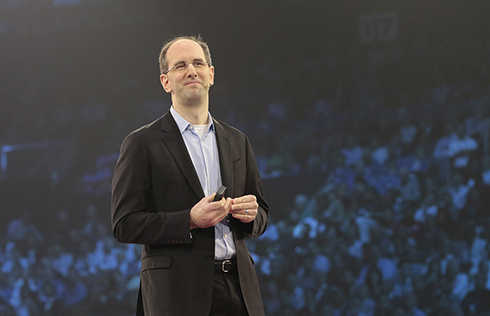I recently purchased the hard back copy of Hit Refresh, the new book by Microsoft CEO Satya Nadella. I got it at MS Ignite, and read it on the plane between Orlando and Seattle, and Seattle and San Francisco (a week later).
The book is much like an episode of the TV show, Arrow, blending today with flashbacks of Nadella’s past, using his life story to explain his outlook on managing Microsoft’s future. The book is split into two, first explaining how Nadella got the role and his mission to change the culture of Microsoft, and then the last few chapters explain what Nadella sees as the future.
Most of the first few chapters explain Nadella’s childhood and entry into IT. He wasn’t the classic nerd; he wanted to be a cricket player – that’s like wanting to be a baseball player in the USA, but maybe bigger considering how popular cricket is in a huge country such as India. His father gave him the present of a computer, and like many with an early home computer (ZX-81, I think), he started programming in BASIC, and learned the power of code. Nadella discusses his journey to America, and to Microsoft. Of huge importance, is his personal life and how it formed his outlook on life. Microsoft’s renewed (and genuine) focus on accessibility and community involvement can be better understood by understanding the man.
Nadella’s mission with Microsoft was to change the culture. If you knew Microsoft employees from 5 years ago, they weren’t a happy bunch. Enron’s stack ranking system was used to review staff – someone in the team must always get the “stinker” review – and why would anyone copy anything from Enron, seriously!?!?! The company appeared to have no mission, petty fiefdom squabbling killed innovation, and Microsoft became a place where innovation was unacceptable. Microsoft had plans to get into mobile very early on, but they were killed off. Sinofsky was … you know already! Microsoft was always late to every party, and had become reliant on Office software & Windows sales, both of which were at huge risk. He knew all this, he’d seen things he disagreed with (acquisition of Nokia), and wanted a root change within the corporation.
Phrases like “growth mindset”, “culture change” and “empathy” are throughout the book. Every decision must help the corporation grow – for example, acquiring Minecraft wasn’t an obvious case of growth, but it’s been a marketing coup and has Microsoft products/services in the hands of most under-10s out there. Closing Nokia killed a cancer that was eating Microsoft. And most of all, Nadella did start a culture change. I’ve been dealing with Redmond and engineering teams for 10 years now. In 2010-2012, Microsoft was a bit of a black hole. In 2014, Microsoft was very different; instead of telling us what to think, we were being asked for our thoughts and opinions. I can look at WS2016 and point out things that I and other Windows Server MVPs gave feedback on, including one that MS didn’t think was necessary at all, which became a key feature! I’m regularly in contact with Azure program managers who are hungry for feedback.
Today’s Microsoft takes smart chances with Surface, creates HoloLens, forms alliances with old rivals (Salesforce, RedHat, Apple, Amazon, and more) where there are mutual opportunities that benefit both sets of customers. Microsoft has bent over so far backwards to embrace opensource in Azure that they are probably the most open-friendly public cloud around.
It wasn’t easy for Nadella to accomplish this. He goes into a lot of detail about how this was done. Some of his approaches were rebuffed a bit at first, he broke some traditions, but these are things that needed to be broken.
In the final chapters, he talks about the future of Microsoft. He’s clear that Microsoft completely missed the boat when it came to mobile devices. Microsoft was too late to market and there wasn’t room for a 3rd platform. He’s quite clear about that in interviews – what can Microsoft do that will be different and attractive enough to bring a critical mass of customers to a new product? Simple being another OS doesn’t cut it, and several years of 3 generations of Windows Phone/Mobile proved that. What Microsoft does bring is genius, and the power of the cloud. Microsoft’s big push for the future is based on IoT, AI, and quantum computing. The three solutions are intertwined and there is an indirect consumer link – a customer’s freezer can malfunction, a bot can reach out, and that bot’s AI could be trained/enhanced by quantum computing.
This book isn’t going to change your life. There’s no life & death car chases. No one barely escapes being eaten by a black hole. But if you are interested in the world of Microsoft, this might be an interesting read to understand the new Microsoft. A lot of the text is very Nadella-keynote, being repetitive, dry, and conceptual. But you will come away understanding his thought process, realizing how well read and educated the man his, how he thinks deep about everything, and most of all, why empathy is so important to him.










































